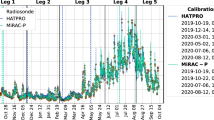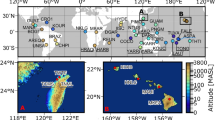Abstract
The HAMSTRAD (H2O Antarctica Microwave Stratospheric and Tropospheric Radiometers) microwave radiometer operating at 60 GHz (oxygen line, thus temperature) and 183 GHz (water vapour line) has been permanently deployed at the Dome C station, Concordia, Antarctica [75°06′S, 123°21′E, 3,233 m above mean sea level] in January 2010 to study long-term trends in tropospheric absolute humidity and temperature. The great sensitivity of the instrument in the lowermost troposphere helped to characterize the diurnal cycle of temperature and H2O from the austral summer (January 2010) to the winter (June 2010) seasons from heights of 10 to 200 m in the planetary boundary layer (PBL). The study has characterized the vertical resolution of the HAMSTRAD measurements: 10–20 m for temperature and 25–50 m for H2O. A strong diurnal cycle in temperature and H2O (although noisier) has been measured in summertime at 10 m, decreasing in amplitude with height, and phase-shifted by about 4 h above 50 m with a strong H2O–temperature correlation (>0.8) throughout the entire PBL. In autumn, whilst the diurnal cycle in temperature and H2O is less intense, a 12-h phase shift is observed above 30 m. In wintertime, a weak diurnal signal measured between 10 to 200 m is attributed to the methodology employed, which consists of monthly averaged data, and that combines air masses from different origins (sampling effect) and not to the imprint of the null solar irradiation. In situ sensors scanning the entire 24-h period, radiosondes launched at 2000 local solar time (LST) and European Centre for Medium-Range Weather Forecasts (ECMWF) analyses at 0200, 0800, 1400 and 2000 LST agree very well with the HAMSTRAD diurnal cycles for temperature and relatively well for absolute humidity. For temperature, HAMSTRAD tends to be consistent with all the other datasets but shows a smoother vertical profile from 10 to 100 m compared to radiosondes and in-situ data, with ECMWF profiles even smoother than HAMSTRAD profiles, and particularly obvious when moving from summer to winter. For H2O, HAMSTRAD measures a much moister atmosphere compared to all the other datasets with a much weaker diurnal cycle at 10 m. Our study has helped characterize the time variation of the PBL at Dome C with a top around 200 m in summertime decreasing to 30 m in wintertime. In summer, from 2000 to 0600 LST a stable layer is observed, followed by a well-mixed layer the remaining time, while only a nocturnal stable layer remains in winter. In autumn, a daytime convective layer shallower than the nocturnal stable layer develops.
Similar content being viewed by others
References
Argentini S, Viola A, Sempreviva AM, Petenko I (2005) Summer boundary-layer height at the plateau site of Dome C, Antarctica. Boundary-Layer Meteorol 115: 409–422
Aristidi E, Agabi K, Vernin J, Azouit M, Martin F, Ziad A, Fossat E (2003) Antarctic site testing: first daytime seeing monitoring at Dome C. Astron Astrophys 406: 19–22
Aristidi E, Agabi K, Azouit M, Fossat E, Vernin J, Travouillon T, Lawrence JS, Meyer C, Storey JWV, Halter B, Roth WL, Walden V (2005) An analysis of temperatures and wind speeds above Dome C, Antarctica. Astron Astrophys 430: 739–746
Cimini D, Westwater ER, Gasiewski AJ, Klein M, Leuski VY, Liljegren JC (2007a) Ground-based millimeter- and submillimeter-wave observations of low vapor and liquid contents. IEEE Trans Geosci Remote Sens 45: 2169–2180
Cimini D, Westwater ER, Gasiewski AJ, Klein M, Leuski VY, Dowlatshabi S (2007b) The ground-based scanning radiometer: a powerful tool for study of the Arctic atmosphere. IEEE Trans Geosci Remote Sens 45: 2759–2777
Connolley WM (1996) The Antarctic temperature inversion. Int J Climatol 16: 1333–1342
Davis D, Nowak JB, Chen G, Buhr M, Arimoto R, Hogan A, Eisele F, Mauldin L, Tanner D, Shetter R, Lefer B, McMurry P (2001) Unexpected high levels of NO observed at South Pole. Geophys Res Lett 28: 3625–3628
Genthon C, Town MS, Six D, Favier V, Argentini S, Pellegrini A (2010) Meteorological atmospheric boundary layer measurements and ECMWF analyses during summer at Dome C, Antarctica. J Geophys Res. doi:10.1029/2009JD012741
Hines KM, Bromwich DH, Rasch PJ, Iacono MJ (2004) Antarctic clouds and radiation within the NCAR climate models. J Clim 17: 1198–1212
Hudson SR, Brandt RE (2005) A look at the surface-based temperature inversion on the Antarctic Plateau. J Clim 18: 1673–1696
Jones AE, Weller R, Andreson PS, Jacobi HW, Wolff EW, Schrems O, Miller H (2001) Measurements of NOx emissions from the Antarctic snowpack. Geophys Res Lett 28: 1499–1502
King JC, Argentini S, Anderson P (2006) Contrasts between the summertime surface energy balance and boundary layer structure at Dome C and Halley stations, Antarctica. J Geophys Res. doi:10.1029/2005JD006130
Mattioli V, Westwater ER, Cimini D, Gasiewski AJ, Klein M, Leuski VY (2008) Microwave and Millimeter-wave Radiometric and Radiosonde observations in an Arctic environment. J Atmos Ocean Technol 25: 1768–1777
Pazmany AL (2007) A compact 183-GHz radiometer for water vapor and liquid water sensing. IEEE Trans Geosci Remote Sens 45: 2202–2206
Racette PE, Westwater ER, Han Y, Gasiewski A, Klein M, Cimini D, Manning W, Kim E, Wang J, Kiedron P (2005) Measurement of low amounts of precipitable water vapor using ground-based millimeterwave radiometry. J Atmos Ocean Technol 22: 317–337
Ricaud P, Gabard B, Derrien S, Chaboureau J-P, Rose T, Mombauer A, Czekala H (2010a) HAMSTRAD-Tropo, A 183-GHz Radiometer dedicated to sound tropospheric water vapor over Concordia Station, Antarctica. IEEE Trans Geosci Remote Sens 48: 1365–1380
Ricaud P, Gabard B, Derrien S, Attié J-L, Rose T, Czekala H (2010b) Validation of tropospheric water vapor as measured by the 183-GHz Radiometer HAMSTRAD-Tropo over the Pyrenees Mountains, France. IEEE Trans Geosci Remote Sens 48: 2189–2203
Ricaud P, Derrien S, Chaboureau J-P, Attié J-L, Rose T, Czekala H, Genthon C, Genoni L, Pellegrini A, Durand G (2010c) The 183-GHz Radiometer HAMSTRAD: first measurements of temperature and humidity in the PBL at Dome C (Antarctica). In: ISARS 2010 Symposium, Paris, France
Ricaud P, Carminati F, Attié J-L, Canut G, Derrien S, Courcoux Y, Rose T, Genthon C, Six D, Genoni L, Pellegrini A, Durand G, Tremblin P, August T, Vanacker J-F (2011) Quality assessment of the first measurements of tropospheric water vapor and temperature by the HAMSTRAD Radiometer over Concordia Station, Antarctica. IEEE Trans Geosci Remote Sens, in press
Stratospheric Processes And their Role in Climate (2000) In: Kley D, Russell JM III, Phillips C (eds) SPARC Assessment of Upper Tropospheric and Stratospheric Water Vapour, 312 pp
Stull RB (1988) An introduction to boundary layer meteorology. Kluwer, Dordrecht, 666 pp
Tomasi C, Petkov B, Benedetti E, Vitale V, Pellegrini A, Dargaud G, De Silvestri L, Grigioni P, Fossat E, Roth WL, Valenziano L (2006) Characterization of the atmospheric temperature and moisture conditions above Dome C (Antarctica) during austral summer and fall months. J Geophys Res. doi:10.1029/2005JD006976
Town MS, Walden VP (2009) The surface energy budget and behavior of the stable boundary layer over the South Pole. J Geophys Res. doi:10.1029/2009JD011888
Tremblin P, Minier V, Schneider N, Durand G, Challita Z, Fossat E, Reinert Y, Ricaud P, Sabbatini L, Storey J, Urban J, Veyssiere C, Walter C (2011) Site testing for submillimetre astronomy at Dome C in Antarctica. Astron Astrophys, in press
Westwater ER, Crewell S, Mätzler C (2004) A review of surface-based microwave and millimeter-wave radiometric remote sensing of the troposphere. Radio Sci Bull 3010: 59–80
Westwater ER, Cimini D, Mattioli V, Gasiewski A, Klein M, Leuski V, Liljegren J (2006) The 2004 North Slope of Alaska Arctic Winter Radiometric Experiment: overview and highlights. In: Proc Microw Spec Meeting, San Juan, Puerto Rico, pp 77–81
Author information
Authors and Affiliations
Corresponding author
Rights and permissions
About this article
Cite this article
Ricaud, P., Genthon, C., Durand, P. et al. Summer to Winter Diurnal Variabilities of Temperature and Water Vapour in the Lowermost Troposphere as Observed by HAMSTRAD over Dome C, Antarctica. Boundary-Layer Meteorol 143, 227–259 (2012). https://doi.org/10.1007/s10546-011-9673-6
Received:
Accepted:
Published:
Issue Date:
DOI: https://doi.org/10.1007/s10546-011-9673-6




